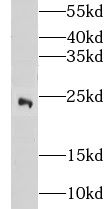Products
CITED2 antibody
| Size | Price |
|---|---|
| 100µg | Inquiry |
- SPECIFICATIONS
- FIGURES
- CONDITIONS
- FAQS
- Product Name
- CITED2 antibody
- Catalogue No.
- FNab01721
- Size
- 100μg
- Form
- liquid
- Purification
- Immunogen affinity purified
- Purity
- ≥95% as determined by SDS-PAGE
- Clonality
- polyclonal
- Isotype
- IgG
- Storage
- PBS with 0.02% sodium azide and 50% glycerol pH 7.3, -20℃ for 12 months(Avoid repeated freeze / thaw cycles.)
- Immunogen
- Cbp/p300-interacting transactivator, with Glu/Asp-rich carboxy-terminal domain, 2
- Alternative Names
- Cbp/p300-interacting transactivator 2|MSG-related protein 1 (MRG-1)|P35srj|CITED2|MRG1 antibody
- UniProt ID
- Q99967
- Observed MW
- 24 kDa
- Tested Applications
- ELISA, WB
- Recommended dilution
- WB: 1:500-1:2000
 SH-SY5Y cells were subjected to SDS PAGE followed by western blot with FNab01721(CITED2 antibody) at dilution of 1:500
SH-SY5Y cells were subjected to SDS PAGE followed by western blot with FNab01721(CITED2 antibody) at dilution of 1:500
- Background
- Transcriptional coactivator of the p300/CBP-mediated transcription complex. Acts as a bridge, linking TFAP2 transcription factors and the p300/CBP transcriptional coactivator complex in order to stimulate TFAP2-mediated transcriptional activation. Positively regulates TGF-beta signaling through its association with the SMAD/p300/CBP-mediated transcriptional coactivator complex. Stimulates the peroxisome proliferator-activated receptors PPARA transcriptional activity. Enhances estrogen-dependent transactivation mediated by estrogen receptors. Acts also as a transcriptional corepressor; interferes with the binding of the transcription factors HIF1A or STAT2 and the p300/CBP transcriptional coactivator complex. Participates in sex determination and early gonad development by stimulating transcription activation of SRY. Plays a role in controlling left-right patterning during embryogenesis; potentiates transcriptional activation of NODAL-mediated gene transcription in the left lateral plate mesoderm(LPM). Plays an essential role in differentiation of the adrenal cortex from the adrenogonadal primordium(AGP); stimulates WT1-mediated transcription activation thereby up-regulating the nuclear hormone receptor NR5A1 promoter activity. Associates with chromatin to the PITX2 P1 promoter region.
How many times can antibodies be recycled?
First, usually it's not suggested to recycle antibodies. After use, buffer system of antibodies has changed. The storage condition of recycled antibodies for different customers also varies. Thus, the performance efficiency of recycled antibodies can’t be guaranteed. Besides, FineTest ever conducted the antibody recycling assay. Assay results show recycling times of different antibodies also varies. Usually, higher antibody titer allows more repeated use. Customers can determine based on experimental requirements.
Notes: After incubation, we recycle rest antibodies to centrifuge tube and store at 4℃. High titer antibodies can be stored for a minimum of one week. Reuse about three times.
What are components of FineTest antibody buffer?
Components of FineTest antibody buffer are usually PBS with proclin300 or sodium azide, BSA, 50% glycerol. Common preservative is proclin300 or sodium azide, which is widely applied in the lab and industry.
How about the storage temperature and duration of FineTest antibodies?
Most antibodies are stored at -20℃. Directly-labeled flow cytometry antibodies should be stored at 2 - 8℃. The shelf life is one year. If after sales issues for purchased antibodies appear, return or replacement is available. Usually, antibodies can be still used after the one-year warranty. We can offer technical support services.
Is dilution required for FineTest antibodies? What’s the dilute solution?
Directly-labeled flow cytometry antibodies are ready-to-use without dilution. Other antibodies are usually concentrated. Follow the dilution ratio suggested in the manual. Dilute solution for different experiments also varies. Common antibody dilution buffers are acceptable(e.g. PBST, TBST, antibody blocking buffer).
How to retrieve antibodies for immunohistochemistry?
Common retrieval buffers: Tris-EDTA Buffer(pH 9.0); Citrate Buffer(pH 6.0)
Heat induced antibody retrieval:
Method 1: Water-bath heating: Put the beaker with retrieval buffer and slide in the boiling water bath. Keep the boiling state for 15min. Naturally cool to room temperature;
Method 2: Microwave retrieval: Put the beaker with retrieval buffer and slide in the microwave oven. Heat at high power for 5min, Switch OFF for 3min, Heat at medium power for 5min. Naturally cool to room temperature.
How to choose secondary antibodies?
(1) Secondary antibodies react with primary antibodies. Thus, secondary antibodies should be against host species of primary antibodies. E.g. If the primary antibody is derived from rabbit, the relevant secondary antibody should be against rabbit. E.g. goat anti rabbit or donkey anti rabbit.
(2) Choose secondary antibody conjugates according to the experimental type, e.g. ELISA, WB, IHC etc. Common enzyme conjugated secondary antibodies are labelled by HRP, AP etc. Fluorescin or dye labelled secondary antibodies are applied in immunofluorescence and flow cytometry(e.g. FITC, Cy3).
